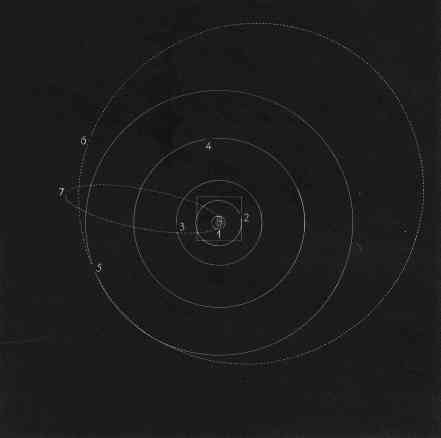| Cosmic View: The Universe in 40 Jumps by Kees Boeke (1957) |
page 19 |
|
| TOP Flaps 1 2 3 4 5 6 7 8 9 10 11 12 13 14 15 16 17 18 19 20 21 22 23 24 25 26 27 28 29 30 31 32 33 34 35 36 37 38 39 40 41 42 43 44 45 46 47 48 |
| Powers of ten: 1 2 3 4 5 6 7 8 9 10 11 12 13 14 15 16 17 18 19 20 21 22 23 24 25 26 27 <> 1 0 -1 -2 -3 -4 -5 -6 -7 -8 -9 -10 -11 -12 -13 |
 | |||
| 14. |
The whole solar system is now in view. The sun and the planets nearest it - Mercury,
Venus, Earth, Mars - have together been reduced to a tiny circle (1), but
the other planets and their wider orbits are clearly seen: Jupiter (2), Saturn (3),
Uranus (4), Neptune (5), and Pluto (6). The latter's orbit at one place comes inside
Neptune's. The whole orbit of Halley's Comet is here; also its position in
1951 (7). It will be near the earth again in 1986. The elliptic nature of the
planets' orbits has been taken into account. In most cases, however, this again
means only that the sun is not in the center of an orbit, for the difference of
its shape from the circle cannot be seen in any of them except Pluto's. The inclination
of the orbits to the plane of the horizon of Bilthoven has been neglected.
Light would on this scale travel about 1 centimeter per hour.
| ||
|
This content is from Kees Boeke's book, Cosmic View: The Universe
in 40 Jumps. It has been placed online without permission. Copyright (C) 1957 by Kees Boeke. All rights reserved. No part of this book may be reprinted, or reproduced or utilized in any form or by any electronic, mechanical or other means, now known or hereafter invented, including photo-copying and recording, or in any information storage and retrieval system, without permission. |